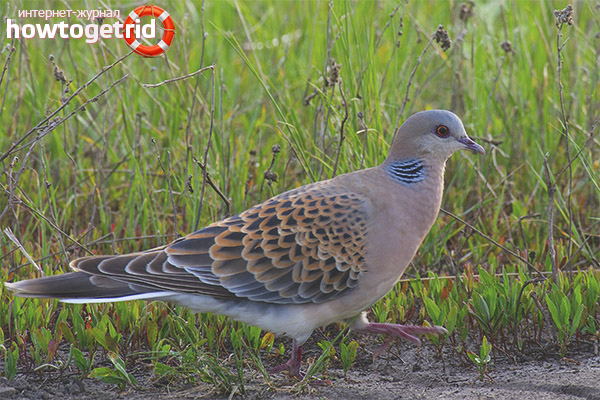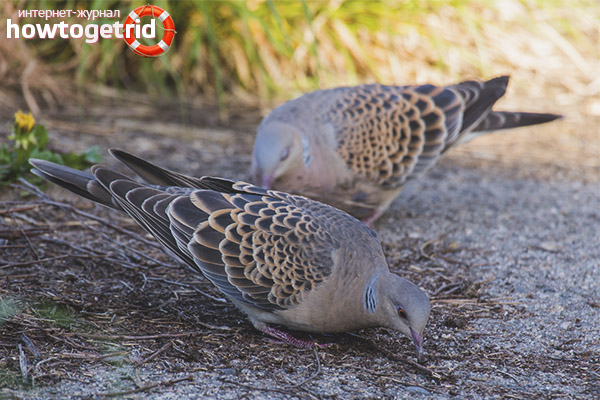The content of the article
The big neck is one of the largest birds, resembling in appearance the average size of a blue dove. The body length of representatives of this species is about 30 cm. The weight of the big neck is not more than 150 grams.
The main habitat of individuals is the African and Eurasian continent. As a rule, as a place for the construction of their nests, these relatives of pigeons choose rather tall trees in park areas and city gardens.
Most often, you can see this bird sitting horizontally on the tops of trees or on telegraph wires. Places for feeding - roadsides of country roads, paths. On the ground they move very quickly, in small steps. In the air, the turtledove flies straightforwardly and fairly quickly, usually it selects small heights for the flight, flaps its wings noisily during movement, which produce a characteristic crackle.
Streptopelia - sociable birds, often sitting on trees, willingly let a person close to them, however, when it approaches, they abruptly break into the air and fly away. In those countries and regions where doves are hunted, representatives of the species do not allow a person to be closer than 100 meters. The flight speed of these birds reaches 60 km / h. During the flight of the Streptopelia can be seen a noticeable transverse light strip on the tail, which clearly distinguishes this species of birds.
Description and features of the species
The plumage color in adult representatives of this species of birds is cream-colored with a gray tint, the feather cover of the wings is reddish with small black specks, the tail is dark with a characteristic transverse stripe of light color. Black and white spots are present on the neck. The legs of the bird are pink. Male doves, as a rule, are slightly larger than their girlfriends. The plumage of young birds is similar to the outfit of adults, however, it is not so bright, the legs are brown in color, the iris is brownish, there are no spots on the neck.
Power Features
The basic diet of the big neck of the neck is a variety of seeds, insects. In the warm season, the main places for food production are meadows, the coastal zone of small freshwater rivers. In the autumn period, large doves acquire their food in the fields, collecting grains from the surface of the earth (wheat, rice, buckwheat, millet, hemp).
Habitat
The most widespread bird in Africa, Europe, Central Asia. The main habitat is the steppe, forest-steppe. This type of bird belongs to migratory birds; the place of winter turtledove is South Sahara, Africa. From the hibernation, they arrive at the nesting place after the trees are already covered with deciduous cover.
The differences between male and female, especially breeding
Note that for this type of bird, such as large turtledoves, sexual dimorphism is not a characteristic feature. The only difference between the female and the male is the larger sizes of the male, there are no differences in the color of plumage.
The nesting period for representatives of this species of birds is quite long; this is often manifested in the fact that some pairs of birds are already hatching their offspring, while others are just starting to build and equip their nest.
The male in the mating season attracts the female of the Streptopelia with characteristic clicking and gentle, monotonous coo. During the reproduction of such sounds, the bird’s neck swells, its head drops down.
As a rule, for nesting birds choose forest edges, gardens, park areas, forest plantations. As a material for the construction of the nest, plant roots and brushwood are used. Directly the bird’s nest itself is built on the branches of trees.
The number of eggs in one treasure is 2 pcs. They are gently cream or white, have the correct shape. The duration of the incubation is about 2 weeks.
After hatching offspring, parents take care and protect their chicks until they reach the last independence. Young doves of the dobroke become winged after 3 weeks after hatching. As a rule, after this they leave the parent nesting site and form into small flocks (up to 10 birds). In regions with a mild and warm climate, during the nesting season of Streptopelia can make several egg laying (no more than 2).
Voice Features
Interesting Facts
- Streptopelia is a sociable species of birds, and they quickly get used to a person, therefore they calmly endure life in captivity.
- According to studies, DNA analysis of birds of the pigeon family, which include the common dove, revealed high rates of similarity with an extinct bird species like the Dodo bird.
- The first documented references to representatives of the pigeon family appeared more than five thousand years ago (Mesopotamia).
Video: large turtledove (Streptopelia orientalis)











Submit